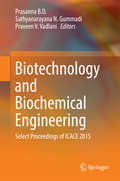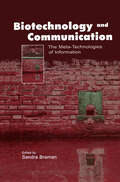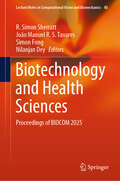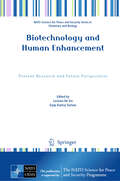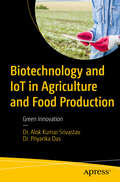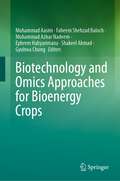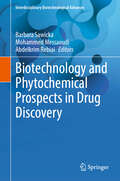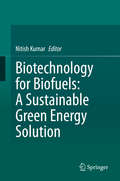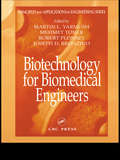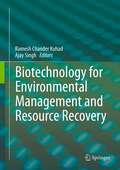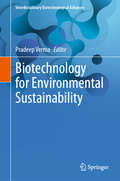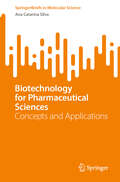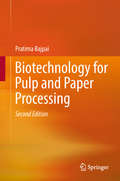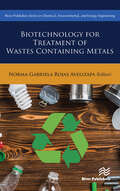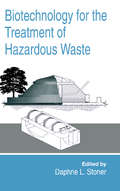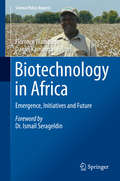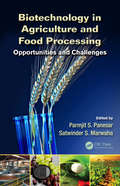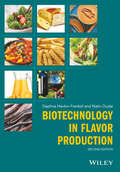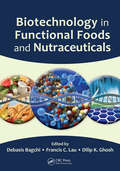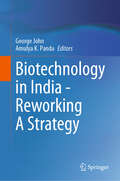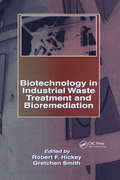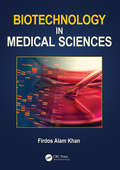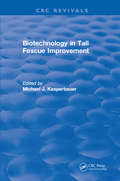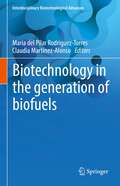- Table View
- List View
Biotechnology and Biochemical Engineering: Select Proceedings of ICACE 2015
by Prasanna B. D. Sathyanarayana N. Gummadi Praveen V. VadlaniThis book serves to highlight the seamless integration of the sciences leading to sustainable technologies. Chemical engineering is one of the major disciplines catering to the societal needs in the fields of energy, environment and materials. The chapters of this book have been selected to encompass the latest in industrial biotechnology and biochemical engineering principles and applications. The chapters are included here after careful review for content and depth. The book focuses on the relatively new areas of molecular biotechnology and nanotechnology which have a strong impact at the fundamental and process levels in chemical engineering. The book also covers analytical procedures, experimental techniques and process analysis in bioprocessing, bioremediation, green separation methods, and emerging nanoparticle applications. It should be useful to students, academicians, and practitioners alike.
Biotechnology and Communication: The Meta-Technologies of Information (Routledge Communication Series)
by Sandra BramanThis volume examines the convergence of biotechnology and communication systems and explores how this convergence directly influences our understanding of the nature of communication. Editor Sandra Braman brings together scholars to examine this convergence in three areas: genetic information and "facticity"; social issues and implications; and the economic and legal issues raised by the production and ownership of information. The work highlights the sophisticated processes taking place as biotechnology and information technology systems continue to evolve. The chapters in this book approach the complex history of this topic and the issues it raises from a number of directions. It begins by examining the shared features and spaces of biotechnology and digital information technologies as meta-technologies--qualitatively distinct from both the tools first used in the premodern era and the industrial technologies that characterized modernity. Next, the book explores what is and is not useful in treating the types of information processed by the two meta-technologies through a shared conceptual lens and looks at issues raised by the ownership of genetic and digital information. The final chapters are concerned with relationships between information and power. Defining a future research agenda for communication scholarship, this work is beneficial to scholars and students in science communication, cultural studies, information technologies, and sociology.
Biotechnology and Health Sciences: Proceedings of BIOCOM 2025 (Lecture Notes in Computational Vision and Biomechanics #40)
by João Manuel R. S. Tavares Nilanjan Dey Simon Fong R. Simon SherrattThis book reports on timely research at the interface between biomedical engineering and intelligence technologies applied to biology and health care. It covers cutting-edge methods applied to biomechanics and robotics, EEG time series analysis, blood glucose prediction models, among others. It includes peer reviewed papers presented at the Second International Conference on Innovations in Biotechnology and Health Sciences (BIOCOM 2025), held at London, United Kingdom, during 18–19 February 2025.
Biotechnology and Human Enhancement: Present Research and Future Perspectives (NATO Science for Peace and Security Series A: Chemistry and Biology)
by Eyup Kuntay Turmus Luciano De SioThis book provides new insights in the role that biotechnology and human enhancement will play in the following years to come. Based on the experience and know-how of recognized scientists worldwide, a paradigm shift in advanced technologies is highlighted, merging academic and specialized research centers. Indeed, biotechnology and human enhancement play an essential role in emerging fields such as biosensing, medical technologies, and synthetic biology. These technologies are significant for several cross-disciplinary research activities ranging from medicine to electronics. The book promotes a visionary idea that will establish a more vital collaboration to help track down a roadmap for bringing innovative and breakthrough applications to address the key and emerging challenges for the upcoming years. The book is intended to offer a comprehensive overview for both students and experienced researchers about the main research activities developed in recent years that will help realize a more sustainable approach in modern bio-related applications.
Biotechnology and IoT in Agriculture and Food Production: Green Innovation
by Dr. Alok Srivastav Dr. Priyanka DasExplore the transformative intersection of biotechnology and the Internet of Things (IoT) in modern agriculture. This book delves into sustainable solutions and cutting-edge technologies that are revolutionizing the global food production industry. The book is structured to provide an in-depth understanding of how green innovation is reshaping agriculture. Starting with an introduction to sustainability in agriculture, it traces the evolution from traditional farming to smart farming methods, where IoT and Biotechnology come together to optimize crop management, soil health, and resource utilization. Key chapters include the role of IoT in precision farming, biotechnology advancements like CRISPR and GMOs, and their integration for improved crop resilience, pest control, and water management. The synergy between IoT's real-time data capabilities and biotechnology's genetic innovations is highlighted in smart greenhouses, vertical farming, and climate-resilient agriculture. Other critical topics include reducing food waste through technology, the role of AI and machine learning in agricultural practices, blockchain for supply chain transparency, and Biotech's impact on livestock management. Ethical considerations, regulatory frameworks, and green finance opportunities are also addressed, alongside future trends like 5G, drones, and synthetic biology. You will gain a comprehensive view of how biotechnology and IoT are driving sustainable agricultural practices, fostering innovation, and offering solutions to global food security challenges. The book offers practical insights into the future of farming and policy recommendations to ensure a sustainable, tech-driven agricultural future. You Will • Learn how data analytics, AI, and biotech innovations work together in precision farming, optimizing resource usage, improving yields, and addressing environmental challenges • Discover innovative solutions for sustainable food production, including smart irrigation systems, IoT-enabled greenhouses, vertical farming, and biotechnological methods for improving soil health and reducing food waste • Understand the ethical concerns, privacy issues, and regulatory frameworks that govern the use of IoT and biotechnology in agriculture Who Is This Book For Readers with a foundational understanding of agriculture, technology, or sustainability, though no specialized expertise is required. Beginners with an interest in how technology is reshaping food production can grasp the concepts, as the book breaks down complex topics into accessible language. A basic familiarity with IoT and biotech will enhance the learning experience but is not essential for following the book&’s key ideas.
Biotechnology and Omics Approaches for Bioenergy Crops
by Shakeel Ahmad Ephrem Habyarimana Gyuhwa Chung Faheem Shehzad Baloch Muhammad Azhar Nadeem Muhammad AasimThis edited book summarizes the efforts made to develop sustainable bioenergy production through different generations. The topics included in the book cover information about different bioenergy crops, their classification and use as biofuel, agronomic practices to improve biomass yield, classic breeding techniques, genetic diversity, current status and future perspective of bioenergy crops in the omics era. It also discusses application of modern biotechnological and molecular biotechnological techniques for the improvement of bioenergy crops this having enhanced biomass and plant based products. The book explores growing biofuel crops and their impact on environment, bioethics and biosafety issues related to the modern approaches. Another important aspect is the incorporation of nanotechnology for bioenergy crops and biofuel production. All book chapters are contributed renowned researchers in their respective field. This is a unique book covering the bioeneragy crops in the modern omics era. The book is useful for the researchers and post-graduate students to guide them in the field of bioenergy crops.
Biotechnology and Phytochemical Prospects in Drug Discovery (Interdisciplinary Biotechnological Advances)
by Barbara Sawicka Mohammed Messaoudi Abdelkrim RebiaiThis book is a comprehensive exploration of the multifaceted role of phytochemicals in contemporary drug discovery and biotechnology. Comprising eleven insightful chapters, it navigates through the historical roots, current applications, and future possibilities of harnessing plant-derived compounds for medicinal advancements. The initial chapters introduce phytochemicals and their historical significance in traditional medicine, highlighting the scientific validation offered by phytochemistry and pharmacology. The subsequent chapters delve into the incorporation of biotechnology into phytochemical synthesis, focusing on metabolic engineering, synthetic biology, and plant tissue culture to enhance efficiency and reduce environmental impact. The integration of nanomaterial synthesis with medicinal plant extracts is explored for its potential in biomedical applications, such as targeted drug delivery. A thorough examination of bioactive properties of secondary metabolites in unripe fruit extracts reveals their role in immune enhancement, alongside factors affecting bioactive compound content. Advanced analytical techniques crucial to drug discovery are discussed, including "green extraction" and modern methods like high-performance liquid chromatography (HPLC) and gas chromatography (GC) for phytochemical purification and identification. The COVID-19 pandemic has highlighted challenges and strategies in drug discovery, with computational biology advancing molecular target identification and innovative screening methodologies. The exploration of mineral profiling in medicinal plants underscores its importance for human health, detailing methods to identify essential and harmful elements, and noting the nutritional value of these plants. The penultimate chapter addresses future opportunities and challenges in using medicinal plants for drug development, spotlighting India's contributions to global pharmaceutical needs. The final chapter examines phytochemicals as alternative therapeutics against SARS-CoV-2, highlighting antiviral properties and the novel concept of molecular plant farming for vaccine development. This book is a comprehensive resource for those interested in phytochemistry, biotechnology, and pharmacology, elucidating the role of plant-derived chemicals in contemporary medicine and technology.
Biotechnology for Biofuels: A Sustainable Green Energy Solution
by Nitish KumarThe depletion of petroleum-derived fuel and environmental concerns have prompted many millennials to consider biofuels as alternative fuel sources. But completely replacing petroleum-derived fuels with biofuels is currently impossible in terms of production capacity and engine compatibility. Nevertheless, the marginal replacement of diesel with biofuel could delay the depletion of petroleum resources and abate the radical climate change caused by automotive pollutants. Energy security and climate change are the two major driving forces for worldwide biofuel development, and also have the potential to stimulate the agro-industry. The development of biofuels as alternative and renewable sources of energy has become critical in national efforts towards maximum self-reliance, the cornerstone of our energy security strategy. At the same time, the production of biofuels from various types of biomass such as plants, microbes, algae and fungi is now an ecologically viable and sustainable option. This book describes the biotechnological advances in biofuel production from various sources, while also providing essential information on the genetic improvement of biofuel sources at both the conventional and genomic level. These innovations and the corresponding methodologies are explained in detail.
Biotechnology for Biomedical Engineers (Principles and Applications in Engineering)
by Martin L. Yarmush Joseph D. Bronzino Mehmet Toner Robert PlonseyWith the advent of recombinant DNA technology, monoclonal antibody technology, and new technologies for studying and handling cells and tissues, the field of biotechnology has undergone a tremendous resurgence in a wide range of applications pertinent to industry, medicine, and science in general. A volume in the Principles and Applications in Engi
Biotechnology for Environmental Management and Resource Recovery
by Ajay Singh Ramesh Chander KuhadVarious types of secondary agriculture and forestry wastes represent valuable resource materials for developing alternate energy as biofuels and other value added products such as sugars, phenols, furans, organic acids, enzymes and digestible animal feed etc. However, if not managed properly, waste material and environmental contaminants generated by various industries such as food and feed, pulp and paper and textile may lead to severe environmental pollution. The energy, food and feed demand necessitate developing simple and economically viable technologies for environmental management and resource recovery. Microorganisms and their enzymes contribute significantly in utilization of plant residues, resource recovery and eventually in pollution mitigation. "Biotechnology for Environmental Management and Resource Recovery" presents a comprehensive review of selected research topics in a compendium of 16 chapters related to environmental pollution control and developing biotechnologies in agro-ecosystem management and bioconversion of agro-residues (lignocellulosics) into biofuels, animal feed and paper etc. This book provides a valuable resource for reference and text material to graduate and postgraduate students, researchers, scientists working in the area of microbiology, biotechnology, and environmental science and engineering.
Biotechnology for Environmental Sustainability (Interdisciplinary Biotechnological Advances)
by Pradeep VermaThis book covers the broader application of environmental biotechnology for protecting the environment through different bioremediation and biodegradation techniques framed toward removing environmental contaminants, including emerging contaminants. The extensive range of environmental pollutants, which may be organic or inorganic, including toxic heavy metals, radionuclides, synthetic organic dyes, organic compounds, endocrine-disrupting chemicals, pharmaceuticals, and personal care products, etc., continue to pose a threat to human health and ecosystem functioning. The book covers a comprehensive overview of environmental pollutants, including their fate, behavior, and environmental and health risks associated with them. It describes the utilization of bioremediation and phytoremediation processes to provide a superior alternative removal and detoxification of such toxic environmental pollutants directed toward managing ecosystems. It includes an overview of gene modification and omics technology for environment management for the aesthetic approaches to environmental clean-up. Moreover, the book discusses resource recovery from waste using such technologies, which increases the feasibility of the process. Additionally, the book is designed to provide awareness among its readers about major environmental issues like pollution and its management and control through biotechnological means to promote the sustainable development of our society with minimal environmental impact. It also provides technical content regarding the mechanism of bioremediation, biodegradation, and phytoremediation and their field applicability, along with an overview of emerging pollutants and gene modification techniques for remediation applications.
Biotechnology for Pharmaceutical Sciences: Concepts and Applications (SpringerBriefs in Molecular Science)
by Ana Catarina SilvaThis book provides a compact and straightforward overview of the main concepts and applications of Pharmaceutical Biotechnology. The author collates lecture notes on Pharmaceutical Biotechnology to introduce the topic to graduate students in the fields of Pharmaceutical Sciences, Biochemistry, Biotechnology and Industrial Biotechnology, Microbiology, and Medicinal Chemistry. The book starts with an overview of the biotechnological processes needed to develop biological and biosimilar medicines. Next, the author addresses the development and use of advanced therapy medicinal products (ATMPs), including topics such as cell and gene therapies, regenerative medicine and the regulatory issues of biological medicines and ATMPs. Finally, the author explores the limitations of administering biopharmaceuticals, discussing protein and nucleic acid stability issues, potential routes of administration and strategies for improving the bioavailability of biologics and ATMPs. This book captures the latest developments in the field and offers a practical perspective on the topic, serving as a valuable introduction resource not only for graduate students but also for researchers. The basis of the English translation of this book, originally in Portuguese, was facilitated by artificial intelligence. The content was later revised by the author for accuracy.
Biotechnology for Pulp and Paper Processing
by Pratima BajpaiThe book provides the most up-to-date information available on various biotechnological processes useful in the pulp and paper industry. The first edition was published in 2011, covering a specific biotechnological process or technique, discussing the advantages, limitations, and prospects of the most important and popular processes used in the industry. Many new developments have taken place in the last five years, warranting a second edition on this topic. The new edition contains about 35% new material covering topics in Laccase application in fibreboard; biotechnology in forestry; pectinases in papermaking; stickies control with pectinase; products from hemicelluloses; value added products from biorefinery lignin; use of enzymes in mechanical pulping.
Biotechnology for Treatment of Residual Wastes Containing Metals
by Norma Gabriela Rojas-AvelizapaBiotechnology for Treatment of Wastes Containing Metals addresses various aspects related to different wastes that have a metallic content and represent a serious risk for the environment and human health. These wastes, due to their physical and chemical characteristics, have been the object of studies which have led to the development of different technologies in recycling, reuse or adequate disposal, biotechnology being one of these alternatives. Biotechnology offers a range of options for the treatment of types of waste using microorganisms, biomass and their by-products. The mechanisms involved in these waste treatment processes are diverse and complex, and its optimization and efficiency is multifactorial.This text contains nine chapters related to the problem of the metal contamination in the environment as well as some of the different biotechnological alternatives that have been applied for the reduction and/or recovery of metal contamination.
Biotechnology for the Treatment of Hazardous Waste
by Daphne L. StonerThe development of biologically based processes for the treatment of hazardous inorganic and organic wastes is a multi-disciplinary effort requiring the consideration of a number of biological, chemical, and physical parameters, as well as the effective teaming of biologists, chemists, engineers, and regulatory agencies. This new text/reference bridges the disciplines in a unique way, allowing an exchange of fundamental information to take place. The book begins with a description of the biological transformations of inorganic and organic compounds and a review of strategies that may be used for the treatment of hazardous wastes. It continues with a discussion of the physiological and engineering factors that must be considered for successful process development and concludes with a discussion of the regulations that have influenced biological waste treatment and environmental remediation.
Biotechnology in Africa: Emergence, Initiatives and Future (Science Policy Reports #7)
by Florence Wambugu Daniel KamangaIn this book, Florence Wambugu and Daniel Kamanga of Africa Harvest Biotech Foundation International bring together expert African authorities to critique various biotechnology initiatives and project future developments in the field in Africa. For the first time, African voices from multidisciplinary fields as diverse as economics, agriculture, biotechnology, law, politics and academia, demand to be allowed to set the continent's biotech development agenda. This book argues that there is a great future for biotechnology in Africa which sidesteps western interests that do not match those of the local populace. In these diverse chapters, Africa's political and scientific leaders demand a greater say in how research and development funds are allocated and spent. They argue that Africa's political leaders must see both clear benefits and have elbow-room to drive the change required. This is the way that African governments can employ workable policies, suitable biosafety legislation and regulation and respond effectively to public-private partnerships. Wambugu and Kamanga show that biotechnology has the potential to improve food security and standard of living as well as mitigate the detrimental effects of climate change on the African continent.
Biotechnology in Agriculture and Food Processing: Opportunities and Challenges
by Parmjit S. Panesar Satwinder S. MarwahaAn instructive and comprehensive overview of the use of biotechnology in agriculture and food production, Biotechnology in Agriculture and Food Processing: Opportunities and Challenges discusses how biotechnology can improve the quality and productivity of agriculture and food products. It includes current topics such as GM foods, enzymes, and prod
Biotechnology in China II: Chemicals, Energy and Environment (Advances in Biochemical Engineering/Biotechnology #122)
by Jian Chen Pingkai Ouyang G. T. TsaoPast, Present, and Future Industrial Biotechnology in China, by Zhenjiang Li, Xiaojun Ji, Suli Kan, Hongqun Qiao, Min Jiang, Dingqiang Lu, Jun Wang, He Huang, Honghua Jia, Pingkai Ouyuang, and Hanjie Ying.- Organic Chemicals from Bioprocesses in China, by Jin Huang, Lei Huang, Jianping Lin, Zhinan Xu, and Peilin Cen.- Biofuels in China, by Tianwei Tan, Jianliang Yu, Jike Lu, and Tao Zhang.- Bioreactors and Bioseparation, by Siliang Zhang, Xuejun Cao, Ju Chu, Jiangchao Qian, and Yingping Zhuang.- Environmental Biotechnology in China, by Shuang Jiang Liu , Lei Liu , Muhammad Tausif Chaudhry , Lei Wang , Ying Guang Chen , Qi Zhou , He Liu , and Jian Chen.- Traditional Chinese Biotechnology, by Yan Xu , Dong Wang , Wen Lai Fan , Xiao Qing Mu, and Jian Chen.- Modern Biotechnology in China, by Qing-Zhao Wang and Xue-Ming Zhao.
Biotechnology in Flavor Production
by Daphna Havkin-Frenkel Nativ DudaiThroughout history, human beings have sought ways to enhance the flavor of the foods they eat. In the 21st century, biotechnology plays an important role in the flavor improvement of many types of foods. This book covers many of the biotechnological approaches currently being applied to flavor enhancement. The contribution of microbial metabolism to flavor development in fermented beverages and dairy products has been exploited for thousands of years, but the recent availability of whole genome sequences of the yeasts and bacteria involved in these processes is stimulating targeted approaches to flavor enhancement. Chapters discuss recent developments in the flavor modification of wine, beer, and dairy products through the manipulation of the microbial species involved. Biotechnological approaches to the production of specific flavor molecules in microbes and plant tissue cultures, and the challenges that have been encountered, are also covered, along with the metabolic engineering of food crops for flavor enhancement - also a current area of research. Biotechnology is also being applied to crop breeding through marker-assisted selection for important traits, including flavor, and the book looks at the application of the biotechnological approach to breeding for enhanced flavor in rice, apple, and basil. These techniques are subject to governmental regulation, and this is addressed in a dedicated chapter. This updated second edition features five brand new chapters, and the topics covered in the book will be of interest to those in the flavor and food industries as well as to academic researchers interested in flavors.
Biotechnology in Functional Foods and Nutraceuticals
by Debasis Bagchi Francis C. Lau Dilip K. GhoshModern food biotechnology is now a billion-dollar industry, producing functional foods and nutraceuticals that offer a whole host of increased health benefits, including prevention against illness, and chronic and degenerative conditions. Written by a team of top-tier researchers and scientists from around the world, Biotechnology in Functional Foo
Biotechnology in India - Reworking A Strategy
by Amulya K. Panda George JohnThis book examines the progress in the biotechnology sector in India towards knowledge and innovation driven Bioeconomy. The chapters of the book review different genome editing techniques and the GM crops focusing on the emerging potential in agricultural biotechnology. Chapters on Vaccines and AI in healthcare unfold huge opportunities in medical biotechnology. The book covers the advances in biotechnology towards delivering important benefits of healthcare, particularly through the pharmaceutical industry focusing on new healthcare interventions and delivering innovations. Further, it explores the major opportunities in industrial biotechnology related to bio-pharma, biorefinery, fermentation biotechnology, and growing synergies between industry-academia. Toward the end, the book also reviews the genetic regulation and the critical role of HRD. In summary, the book emphasizes on India as a strong bio-manufacturing hub for innovative, affordable and accessible products for the society and also for global markets while describing the sector wise strategies required.
Biotechnology in Industrial Waste Treatment and Bioremediation
by Gretchen Smith Robert F. HickeyBiotechnology in Industrial Waste Treatment and Bioremediation addresses the increasingly important topic of waste treatment. Focusing on microbiological degradation of contaminants, it offers a representative picture of the current status of environmental biotechnology and lays a solid foundation of the methods and applications of bioremediation. The expert presentations of case studies in this new book demonstrate successful treatment schemes and technologies meeting regulatory standards. These case studies represent an international cross-section of strategies for developing and implementing the evolving technologies of bioremediation. Biotechnology in Industrial Waste Treatment and Bioremediation examines the primary waste streams, including air, water, soils, and sediments, and explores specific treatment methodologies for industrial and environmental contaminants. This broad and unique coverage allows treatment firms and regulatory authorities to determine and develop appropriate treatment strategies for site-specific problems of waste remediation. The observations and successful field applications compiled in Biotechnology in Industrial Waste Treatment and Bioremediation make it an excellent reference for understanding, evaluating, developing, and operating efficient and cost-effective full-scale treatment systems.
Biotechnology in Medical Sciences
by Firdos Alam KhanAs the field of medical biotechnology grows with new products and discoveries, so does the need for a holistic view of biotechnology in medicine. Biotechnology in Medical Sciences fulfills that need by delivering a detailed overview of medical biotechnology as it relates to human diseases and epidemiology, bacteriology and antibiotics, virology and
Biotechnology in Tall Fescue Improvement
by Michael J. KasperbauerThis one-of-a-kind publication focuses on the improvement of the feed value of tall fescue and further extension of its adaptability under various environmental stresses. This fascinating work comprehensively explains cell and tissue culture methods which are used to establish somatic cell cultures, select among cells, and regenerate plants with the genetic characteristics of the selected cells. This up-to-date volume includes information on cultural haploid plants from immature pollen grains. It also evaluates the plants under various environmental stresses to identify genotypes with superior characteristics. This book also features research data on somatic tissue culture methods and doubled haploids. Biotechnology in Tall Fescue Improvement is an indispensable resource and useful text for all those involved with agronomy, plant physiology, horticultural science, crop science, and botany.
Biotechnology in the generation of biofuels (Interdisciplinary Biotechnological Advances)
by Maria del Pilar Rodriguez-Torres Claudia Martinez-AlonsoThis book approaches biofuels from a new biotechnological perspective with the aim of equipping researchers with a thorough, up-to-date understanding of biofuel research and related technologies. Topics include biomethane, bioethanol, biobutanol, biomass, hydrolysis, bio-oil, microbiology, and many more. Biofuel research has evolved mechanisms to advance their utilization and their application in our system. The chapters will provide concise and up-to-date information to aid our understanding of biotechnology-related implications of biofuels development and its advancements. Readers in the areas of bioengineering, sustainability, renewable energies and biotechnology will find this work useful to widen their knowledge and perspectives on biofuels.
